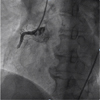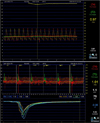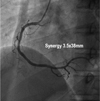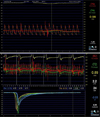Abstract
We investigated the importance of comprehensive physiologic assessment about culprit vessel in STEMI in estimating long-term clinical outcomes after complete revascularization. Comprehensive physiologic assessment provides additional information about microvascular function in coronary artery disease. This assessment includes three indices, fractional flow reserve (FFR), index of microcirculatory resistance (IMR) and coronary flow reserve (CFR). We have performed the comprehensive physiologic assessment in culprit vessels after successful primary PCI in STEMI patients. Both cases were thrombotic total occlusion in mid right coronary artery with inferior wall STEMI, successfully revascularized with stent implantation after thrombus suction. However, in post PCI physiologic assessment, one case showed overt microvascular damage. CFR was 1.1, and IMR was 75U, which was defined as a combined criterion of low CFR (<2.0) and high IMR (≥25U) in culprit vessel, but the other case showed 2.2 in CFR and 24U in IMR, which suggested no overt microvascular damage. Moreover, we can validate these findings by cardiac MR after primary PCI. Previous studies presented that the presence of overt microvascular damage was significantly associated with worse clinical outcome in patients with coronary artery disease. We suggest that comprehensive physiologic evaluation provides important information about the degree of microvascular damage and long-term clinical outcomes after complete revascularization in culprit vessel in STEMI.
Comprehensive physiologic assessment can provide additional information about microvascular function in coronary artery disease. Three physiologic indices, fractional flow reserve (FFR), index of microcirculatory resistance (IMR) and coronary flow reserve (CFR) can be easily measured in culprit vessel of ST elevation myocardial infarction (STEMI) patient after successful primary revascularization. Here, we reports 2 cases of STEMI patients who underwent compressive physiologic assessment in order to determine microvascular function after successful primary revascularization.
A 56 year old man presented with a 4 hours of ongoing chest pain and admitted via emergency department for further evaluation and management. He was non-smoker and he had been treated with hypertension and dyslipidemia in local clinic. He had been taking aspirin 100mg, rosuvastatin 10 mg, and olmesartan 40 mg once a day. He had no family history of cardiovascular disease. His initial electrocardiogram (EKG) showed ST segment elevation in lead II, III, aVF, accompanied with reciprocal changes in V4-6 with ST depression (Fig. 1).
In coronary angiography, total thrombotic occlusion with TIMI 0 flow in mid right coronary artery (RCA) without any measurable collateral flow from non-culprit vessels was notified and the culprit lesion was successfully treated with thrombus suction and stent implantation (Synergy 4.0×28 mm) (Fig. 2). The door to balloon time was 55 minutes. The final angiogram showed TIMI 3 flow without residual stenosis (Fig. 3).
Post-percutaneous coronary intervention (PCI) physiologic study in culprit vessel was performed. FFR under maximal hyperemia using intracoronary nicorandil 2 mg bolus injection was 0.97, however, CFR was depressed to 1.1 and IMR was elevated up to 75 U which suggested the presence of overt microvascular damage in culprit vessel territory (Fig. 4).
Cardiac magnetic resonance imaging (MRI), which was performed 5 days after primary PCI showed intramyocardial hemorrhage in T2 weighted image and microvascular obstruction was also notified in infarcted area after late gadolinium enhancement (Fig. 5).
A 41 year old man presented with a 1 hour history of ongoing resting chest pain and admitted via emergency department for further management. He was current smoker and he had no remarkable medical history. His initial EKG showed ST segment elevation in II,III,aVF with reciprocal changes with ST depression in V2-4 (Fig. 6).
Initial coronary angiography showed thrombotic total occlusion with TIMI 0 flow in mid-RCA without any measurable collateral flow from non-culprit vessels. The culprit vessel was successfully revascularized after thrombus suction and stent implantation (Synergy 3.5x38 mm). The final angiogram showed TIMI 3 flow without residual stenosis (Fig. 7, 8). We also performed post-PCI comprehensive physiologic assessment in culprit vessel. FFR with use of nicorandil was 0.98, CFR was 2.2 and IMR was 24 U. The results from physiologic assessment implied well preserved microvascular function and non-significant flow limitation through epicardial coronary artery as well as microvascular beds (Fig. 9).
Cardiac MRI was taken 2 days after primary PCI and showed difference pattern with case 1. There were no intra-myocardial hemorrhage and edema in T2 weighted image and there was only subtle enhancement in infarcted area and we couldn't find microvascular obstruction in late gadolinium enhancement image (Fig. 10).
Previously, Fearon et al1 showed that elevated IMR value, more than 40 U, is the independent predictive value associated with worse clinical outcome in STEMI patients. And also elevated IMR at the time of STEMI represents larger degree of myocardial and microvascular damage and less recovery of left ventricular function that can be assessed by cardiac enzyme, cardiac MRI, echocardiography, or positron emission tomography.23 Another report from our group presented that not only elevated IMR, but also low CFR was significantly associated with worse clinical outcome in patients with stable coronary artery disease and functionally insignificant epicardial coronary stenosis.4 These findings emphasize the importance of comprehensive physiologic assessment in patients with coronary artery disease. Similarly another reports from Korea also presented the significant association between microvascular damage, which was defined with depressed CFR as well as elevated IMR, and long-term outcomes in STEMI patients after successful revascularization.56 In this case report, we presented the results from the comprehensive physiologic assessment in culprit vessel after primary PCI in STEMI patients and validated the results using cardiac MR findings. There is acute and overt inflammatory change in myocardial cell and vasculature, especially in acute phase of myocardial infarction. Nevertheless, the reproducibility of IMR measurement and prognostic implication in patients with STEMI, even in the acute phase has been presented by previous studies.789
Previous studies showed several mechanisms cause overt microvascular dysfunction. Individual susceptibility (e.g. underlying comorbidity, lack of preconditioning, collateral recruitability), degree and extent of ischemic injury and reperfusion injury cause difference in physiologic findings in these two cases. We think that degree of ischemic injury, especially duration of ischemic event (i.e. symptom to door time), is the one of the major causes of difference in these two cases.
In real world practice, most physicians do not perform the comprehensive physiologic assessment after revascularization of epicardial coronary stenosis. We wanted to emphasize the importance of comprehensive physiologic assessment for microvascular function by presenting these 2 cases with substantially different physiologic findings, even after the successful revascularization for the epicardial coronary stenosis.
In conclusion, comprehensive physiologic evaluation at the time of primary PCI at STEMI is feasible, and low CFR and high IMR highly suggests overt microvascular damage even after the successful revascularization of culprit vessel.
Figures and Tables
 | Fig. 1Initial EKG in Case 1. There is ST elevation in lead II, III, aVF with reciprocal change in V4-6. |
 | Fig. 2Coronary angiography of culprit vessel in Case 1. Total thrombotic occlusion was seen in mid right coronary artery (RCA). |
 | Fig. 3Coronary angiography after successful revascularization in Case 1. We performed PCI with stent implantation, Synergy 4.0×28 mm. |
 | Fig. 4Post-PCI Physiologic assessment in culprit vessel in Case 1. CFR was depressed to 1.1 and IMR was elevated up to 75 U. |
 | Fig. 5Cardiac MR 5 days after primary PCI in Case 1. (A) Intramyocardial hemorrhage was seen in T2 weighted image, (B) Microvascular obstruction in Late gadolinium enhancement. |
 | Fig. 6Initial EKG in Case 2. There is ST elevation in II, III, aVF with reciprocal changes with V2-4. |
 | Fig. 7Coronary angiography in Case 2. Thrombotic total occlusion was seen in mid right coronary artery (RCA). |
 | Fig. 8Coronary angiography after Successful Revascularization in Case 2. We performed PCI with stent implantation, Synergy 3.5×38 mm. |
References
1. Fearon WF, Low AF, Yong AS, McGeoch R, Berry C, Shah MG, et al. Prognostic value of the index of microcirculatory resistance measured after primary percutaneous coronary intervention. Circulation. 2013; 127:2436–2441.

2. McGeoch R, Watkins S, Berry C, Steedman T, Davie A, Byrne J, et al. The index of microcirculatory resistance measured acutely predicts the extent and severity of myocardial infarction in patients with ST-segment elevation myocardial infarction. JACC Cardiovasc Interv. 2010; 3:715–722.

3. van de Hoef TP, Bax M, Meuwissen M, Damman P, Delewi R, de Winter RJ, et al. Impact of coronary microvascular function on long-term cardiac mortality in patients with acute ST-segment-elevation myocardial infarction. Circ Cardiovasc Interv. 2013; 6:207–215.

4. Lee JM, Jung JH, Hwang D, Park J, Fan Y, Na SH, et al. Coronary flow reserve and microcirculatory resistance in patients with intermediate coronary stenosis. J Am Coll Cardiol. 2016; 67:1158–1169.

5. Lim HS, Yoon MH, Tahk SJ, Yang HM, Choi BJ, Choi SY, et al. Usefulness of the index of microcirculatory resistance for invasively assessing myocardial viability immediately after primary angioplasty for anterior myocardial infarction. Eur Heart J. 2009; 30:2854–2860.

6. Park SD, Baek YS, Lee MJ, Kwon SW, Shin SH, Woo SI, et al. Comprehensive assessment of microcirculation after primary percutaneous intervention in ST-segment elevation myocardial infarction: insight from thermodilution-derived index of microcirculatory resistance and coronary flow reserve. Coron Artery Dis. 2016; 27:34–39.

7. Fearon WF, Balsam LB, Farouque HM, Caffarelli AD, Robbins RC, Fitzgerald PJ, et al. Novel index for invasively assessing the coronary microcirculation. Circulation. 2003; 107:3129–3132.





 PDF
PDF ePub
ePub Citation
Citation Print
Print




 XML Download
XML Download